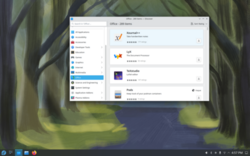Review: Fedora 40 "KDE"
Quoting: DistroWatch.com: Put the fun back into computing. Use Linux, BSD. —
Fedora has always been a bit of a testing ground. Rightly or wrongly it is often viewed as a beta snapshot for upcoming releases of Red Hat Enterprise Linux and, even if we dismiss that viewpoint, it is certainly a proving ground for various third-party projects like GNOME, KDE, systemd, and various developer tools. This means each release of Fedora tends to feel like a beta test rather than a stable release and Fedora 40 very much fits this description.
Some of this choppy behaviour and lack of polish was due to the young Plasma 6 desktop environment. While the KDE team have done a decent job at putting out a new release that is an evolutionary step rather forward than a dramatic fall down the stairs (as we saw with KDE4), there are some issues. There are a few rough edges, some instability, and some nagging problems, particularly with the desktop panel and the System Settings panel. The overall experience isn't bad, but with new desktop releases there are always a few surprises. In my case most of these happened in the virtual machine rather than on my workstation.
Other elements of this unpolished experience were more central to Fedora. The huge amount of memory consumption, making Fedora the heaviest Linux distribution I have used by nearly 50%, was a shock. The system installer is still awkward in places and has a weird layout, especially when it comes to disk partitioning. It feels odd to see Fedora continue to struggle with this when projects like Ubiquity, Calamares, and Pop!_OS have solved these problems years ago. Likewise, Fedora is one of the only distributions, apart from immutable projects, which insists on rebooting to a special update process for every little update. This feels like such a waste of time and a weird regression after spending the past 25 years in the Linux ecosystem where updating has generally been quick and transparent in the background, requiring no pause and (for the userland packages) no reboot.
There were other issues which were less of a serious concern, but odd. Mostly things that were missing from Fedora that are available in other distributions. For example, not being able to adjust Plasma's screen resolution in VirtualBox. This worked with Plasma 6 running on KaOS in VirtualBox (and with GNOME on every other distribution I've used), but not when running either of these desktops on Fedora.
Adding Two:
-
What’s new for Fedora Atomic Desktops in Fedora 40 - Siosm’s blog
Unfortunately, we could not land bootupd support in this release due to an issue found late in Anaconda’s handling of bootupd installations which relied on incomplete functionality in bootupd.
We will attempt to add bootupd again after the release, via an update.
If you encounter Secure Boot errors or need to update your bootloader in the meantime, you can try the instructions from fedora-silverblue#543. Make sure to have a Live USB ready in case you encounter an issue. Please make backups beforehand.
We are hoping to land improvements to bootupd that should simplify this process.
-
What’s new for Fedora Atomic Desktops in Fedora 40 - Fedora Magazine
Fedora Budgie Atomic ships with the latest release of the Budgie Desktop 10.9 “release series”. Budgie 10.9 features some initial porting work to libxfce4windowing as it progresses towards its move to Wayland and redesigns its Bluetooth applet with new direct (dis-)connect functionality.
Additionally, Fedora Budgie Atomic ships with the latest Budgie Control Center and takes into use budgie-session. As Buddies of Budgie officially supports Fedora, Budgie Desktop has also received numerous backported bug fixes to provide Fedora users an even better experience.
You can learn more about the latest happenings in Budgie on the Buddies of Budgie blog.
How-To Geek:
-
Fedora 40: Everything New in the Linux Distro’s Latest Release
They say life begins at 40. Whether that’s true or not, Fedora Linux certainly seems to have found renewed vigor with this milestone release. Fedora was always a fast distribution, and this time round it’s even more noticeable.
Coupled with the speed gains in the new GNOME 46 desktop, you get a blazing user experience. I don’t recall using a Linux desktop as fast as this. But as we’ll see, there’s more to Fedora 40 than speed gains and GNOME 46.
Fedora’s official desktop is GNOME, and that’s the version we checked out. There are 10 other variants, or “spins” of Fedora 40 available, each with a different desktop environment, so you’ve got plenty of choice.

